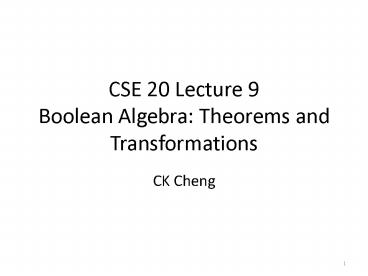CSE 20 Lecture 9 Boolean Algebra: Theorems and Transformations - PowerPoint PPT Presentation
1 / 12
Title:
CSE 20 Lecture 9 Boolean Algebra: Theorems and Transformations
Description:
CSE 20 Lecture 9 Boolean Algebra: Theorems and Transformations CK Cheng * Theorems & Proofs: 4 Postulates P1: a+b = b+a, a b=b a (commutative) P2: a+bc = (a+b) (a ... – PowerPoint PPT presentation
Number of Views:76
Avg rating:3.0/5.0
Title: CSE 20 Lecture 9 Boolean Algebra: Theorems and Transformations
1
CSE 20 Lecture 9Boolean Algebra Theorems and
Transformations
- CK Cheng
2
Theorems Proofs4 Postulates
- P1 ab ba, abba (commutative)
- P2 abc (ab)(ac) (distributive)
- a(bc) ab ac
- P3 a0a, a1 a (identity)
- P4 aa1, aa 0 (complement)
3
- Theorem 6 (Involution Laws)
- For every element a in B, (a')' a
- Proof a is one complement of a'.
- The complement of a' is unique.
- Thus a (a').
- Theorem 7 (Absorption Law) For every pair a,b in
B, a(ab) a a ab a. - Proof a(ab)
- (a0)(ab) (P3)
- a0b (P2)
- a 0 (P3)
- a (P3)
4
Theorems and Proofs
- Theorem 8 For every pair a, b in B
- a ab a b a(a b) ab
- Proof a ab
- (a a)(a b) (P2)
- (1)(a b) (P4)
- a b (P3)
5
Theorem 9 De Morgans Law
- Theorem For every pair a, b in set B
- (ab) ab, and (ab) ab.
- Proof We show that ab and ab are
complementary. - In other words, we show that both of the
following are true (P4) - (ab)(ab) 1, (ab)(ab) 0.
6
Theorem 9 De Morgans Law (cont.)
Proof (Continue) (ab)(ab) (aba)(abb)
(P2) (1b)(a1) (P4) 1 (Theorem 3)
(ab)(ab) (ab)(ab) (P1) abaabb
(P2) 0ba0 (P4) 00 (Theorem 3) 0 (P3)
7
3. Theorems Switching Algebra vs. Multiple
Valued Boolean Algebra
- Boolean Algebra is termed Switching Algebra when
B 0, 1 - When B gt 2, the system is multiple valued.
- Example M (0, 1, 2, 3), ,
0 1 2 3
0 0 0 0 0
1 0 1 0 1
2 0 0 2 2
3 0 1 2 3
0 1 2 3
0 0 1 2 3
1 1 1 3 3
2 2 3 2 3
3 3 3 3 3
8
- iClicker M (0, 1, 2, 3), ,
- Boolean algebra can have only two elements 0,
1. - The identity elements are 0 and 3
- a 0 a
- a 3 a
- C. The complement of 1 is 2
- Two of the above
- None of the above.
0 1 2 3
0 0 1 2 3
1 1 1 3 3
2 2 3 2 3
3 3 3 3 3
0 1 2 3
0 0 0 0 0
1 0 1 0 1
2 0 0 2 2
3 0 1 2 3
9
- Example M (0, 1, 2, 3), ,
- P1 Commutative Laws
- a b b a
- a b b a
- P2 Distributive Laws
- a (b c) (a b) ( a c)
- a (b c) (a b) (a c)
- P3 Identity Elements
- a 0 a
- a 3 a
- P4 Complement Laws
- a a 3
- a a 0
0 1 2 3
0 0 1 2 3
1 1 1 3 3
2 2 3 2 3
3 3 3 3 3
0 1 2 3
0 0 0 0 0
1 0 1 0 1
2 0 0 2 2
3 0 1 2 3
10
Boolean Transform
- Given a Boolean expression, we reduce the
expression (literals, terms) using laws and
theorems of Boolean algebra. - When B0,1, we can use tables to visualize the
operation. - The approach follows Shannons expansion.
- The tables are organized in two dimension space
and called Karnaugh maps.
11
4. Boolean Transformations
- Show that ababab ab
- Proof 1 ababab ab(aa)b P2
- ab b
P4 - a b
Theorem 8 - Proof 2 ababab
- abababab Theorem 5
- ab ab abab P1
- a(bb) (aa)b P2
- a1 1b
P4 - a b
P3
12
Boolean Transformation
- (abc)(ab)(bac)
- (abc)(ab)(b(ac)) (DeMorgans)
- (abc)(ab)b(ac) (DeMorgans)
- (abc)b(ac) (Absorption)
- (abbbc)(ac) (P2)
- (0bc)(ac) (P4)
- bc(ac) (P3)
- abcbcc (P2)
- abc0 (P4)
- abc (P3)































